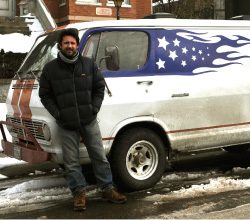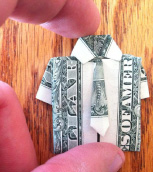One Man’s Journey Across the U.S.
Trek Thunder Kelly is on a three-year quest. He spent 2010 in a different country each month. This, Trek explains, was a year of learning. In 2011 he tended sheep on a Navajo reservation in southeastern Utah, choosing to live in complete isolation for the last four months. This was the year of contemplation. His current 12-month journey is the year of action.
On January 1st, Trek set out to drive through one state per week. Part of his aim was to “attempt to give up my fierce independence and rely on the kindness of others, but the overall goal is to explore and rediscover the good in America.”

“I started in New Mexico because I was born there. It’s an origin for me and with the ancient Puebloan culture, one of America’s origins as well,” he says reverently. His motivation is impassioned, but Trek’s intellectual intensity is balanced by a radiant levity. “I do a dance at each state sign, then hit the visitor’s center.” An attendant at the SLC center gave Trek a miniature origami shirt and tie crafted from a dollar bill. “My schedule is a suggestion. I have recommendations, but I allow everything to be malleable.” In Utah, Trek’s travels took him to Promontory Point, SLC, Park City, the Hindu temple in Spanish Fork, Helper, Green River, Bryce, Zion, Moab, Blanding, Bluff, Monument Valley, Natural Bridges, Glen Canyon, and places in between.
“I’m choosing to see good, so I see it, and traveling alone is great because it forces you to engage. Also, when I jump out of the van wearing a Captain America shirt it predisposes me to a positive first interaction.”
Trek travels in a 1969 GMC Handi-Van he purchased on EBay, embellished with wide red racing stripes, stars in a field of blue flames and the stand-out words “The Good In America” emblazoned on each side. From wheel well to wheel well is painted a red arrow–homage to the van’s namesake, Nez Perce Chief Joseph. Chief had rambled for some 40,000 miles when they had reached Salt Lake City. One of Chief’s many functions is to provide nightly accommodations. Trek has a Walmart-finder app on his phone so, worst-case-scenario, he can join other gypsies in the mega-chain’s nationwide lots where overnight parking is tolerated.
Trek is emphatic, engaging, curious and articulate. “One of the messages I hear from people is, ‘Wow! Wouldn’t it be so great if America were like the old days where people helped each other out?’ Well you know what? It is like that.”
Chief broke down in the Columbia Gorge and a passing farmer and his son stopped to offer assistance. Not only did they drive him to a

parts store and a local welder, they also made a 200-mile trip to return Trek’s pack that he’d forgotten, along with a gift. “Merry Christmas,” they said as they handed him a set of tools. “This kind of thing has happened frequently,” Trek gratefully recalls.
The original plan to chronicle his odyssey was to tap and feed multiple social media resources, but Trek discovered that focusing on just a few outlets is more realistic. “Driving takes so much time out of the day. I get up at six and go until I’m passed out. I have two cameras, I’m taking notes and talking to people, then racing to the next thing; and I’m constantly uploading.” He’s posted thousands of Facebook photos, updated his blog on a monthly basis, and on www.thegoodinamerica.com has tracked, among other categories, numbers of hamburgers and tacos eaten, thumbs-up received by passing motorists and apple seeds planted.
Not only is he seeking good, but also doing good right here in America. “At the end of each week, I try to give back to the state I was in.” Through social media, Trek organizes Help Mobs in which he invites others to join him to perform good in a community. The Help Mobs are an expression of Trek’s belief that action is more important than intention. The Good in America, Trek has experienced, is a reflection of the good in each person.

